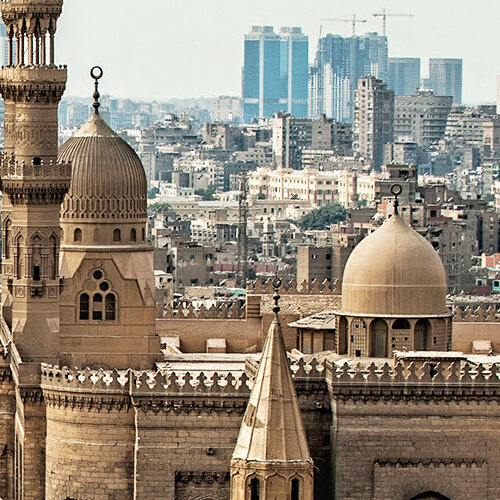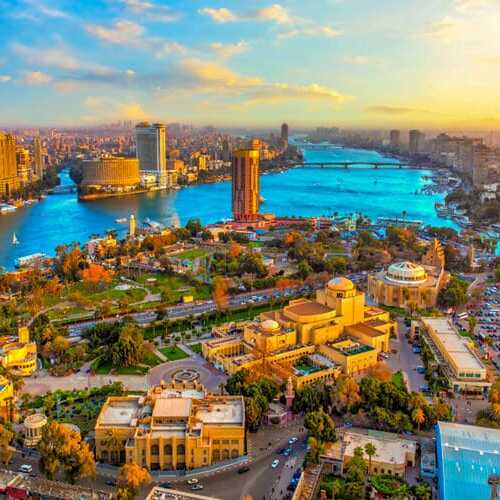No other nation in the world says ‘Welcome’ as often as the Egyptians, and every time, they mean it. While the ancient civilization of Egypt continues to amaze, contemporary Egyptians are equally remarkable.
Aqsunur Mosque
Aqsunur Mosque: The Mamluk Marvel with a Touch of Ottoman Blue in Cairo
Amid the bustling heart of Cairo stands Aqsunur’s Mosque, affectionately known as Cairo’s Blue Mosque. While it shares its moniker with the illustrious Blue Mosque of Istanbul, this Egyptian counterpart boasts its own distinct allure and historical essence. Erected in 1347, it may not compete in scale with Istanbul’s architectural wonder, but Aqsunur’s Mosque captivates with its unique blend of history and artistry.
The mosque predominantly showcases the Mamluk architectural style, a testament to the era in which it was built. However, it harbors an exceptional feature that distinguishes it: a wall splendidly embellished with blue tiles. These tiles, a later addition from the Ottoman period, were integrated into the mosque’s structure about three centuries post its original construction, infusing a piece of Ottoman legacy into the Mamluk canvas.
One of the most striking features of Aqsunur’s Mosque is its minaret. Climbing to its top offers visitors a breathtaking panoramic view, encompassing the imposing Citadel and stretching to the vestiges of the ancient city walls erected under the command of Saladin. This elevated viewpoint offers a unique perspective, not just of Cairo’s geographical expanse but also of its historical depth.
The mosque serves as more than a mere place of worship; it is a gateway into the multilayered history of Cairo. Each element of the mosque, from its Mamluk foundations to its Ottoman-influenced blue tiles, narrates a segment of Cairo’s rich and diverse past. Aqsunur’s Mosque stands as a symbol of the cultural and historical confluence that defines the city, where centuries-old stories are etched in stone and tile.
Visiting Aqsunur’s Mosque is akin to walking through a living museum of Islamic architecture, offering a serene respite amidst the city’s hustle and bustle. It invites introspection and exploration, beckoning visitors to uncover the stories woven into its walls and to appreciate the intricate tapestry of Cairo’s history. In a city teeming with historical landmarks, Aqsunur’s Mosque shines as a blue gem, a reminder of the enduring beauty and cultural richness that Cairo has harbored over the ages.
Created On March 18, 2020
Updated On July 22 , 2025
CAIRO Travel Guide
- Al-Azhar Mosque
- Al-Azhar To The Citadel
- Amir Taz Palace
- Aqsunur’s Mosque
- Bab Zuweila
- Beit Al-Harrawi
- Beit Al-Suhaymi (Al-Suhaymi House)
- Beit Zeinab al-Khatoun
- Bein al-Qasreen STREET (Between The Two Palaces {Street})
- Ben Ezra Synagogue
- Church of St. Barbara
- Coptic Cairo
- Egyptian Textile Museum
- Gawhara Terrace
- Gayer-Anderson Museum
- Ibn Tulun Citadel
- Khan Al-Khalili Bazaar (Cairo’s Most Famous Bazaar)
- Khanqah & Mausoleum of Sultan Baybars al-Gashankir
- Khanqah-Mausoleum of Farag Ibn Barquq
- Madrassa & Mausoleum of as-Salih Ayyub
- Madrassa & Mausoleum of Qalawun
- An-Nasir Mohammed Bin Qalawoon Mosque
- Madrassa And Mausoleum of Barquq
- Mausoleum of Al-Ghouri
- Midan Al-Hussein (Sayedna Al-Hussein Square)
- Mosque of Al-Hakim
- Mosque of Al-Mu’ayyad Shaykh
- Mosque of al-Aqmar
- Mosque of Amr ibn al-As
- Mosque of An-Nasir Mohammed
- Mosque of Aslam al-Silahdar
- Mosque of Ibn Tulun
- Mosque of Mohammed Ali
- Mosque of Sayyidna al-Hussein
- Mosque-Madrassa of Al-Ghouri
- Mosque-Madrassa of Sultan Hassan
- Mosque-Madrassa of Umm Sultan Sha’aban
- Museo Mevlevi
- Museum of Islamic Art
- Northern Cemetery
- Northern Enclosure
- Northern Walls and Gates
- Sabil And Kuttab Of Abdel Rahman Katkhuda
- Sabil of Muhammed Ali Pasha
- Sharia al-Muizz li-Din Allah
- The Church of St Sergius & Bacchus
- The Citadel Of Saladin
- The Complex of Sultan Ashraf Barsbey
- The Coptic Museum (The Only Coptic Museum In Egypt)
- The Egyptian Museum
- The Hanging Church
- The Khayrbek Complex
- The Mosque of Sultan Qaitbey
- The Roman Towers
- Wikala al-Bazara
- Wikala of Al-Ghouri



